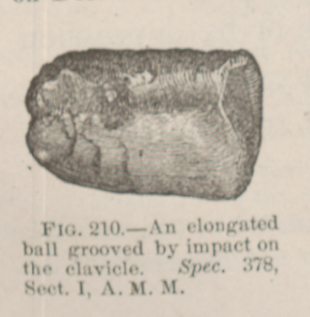Title: Berry, Chalkley
Source text: Surgeon General Joseph K. Barnes, United States Army, The Medical and Surgical History of the War of the Rebellion. (1861–65.), Part 1, Volume 2 (Washington, D.C.: Government Printing Office, 1870), 474.
Civil War Washington ID: med.d1e19183
TEI/XML: med.d1e19183.xml
CASE.—Private Chalkley Berry, Co. I, 28th New Jersey Volunteers, aged 24 years, was wounded at Fredericksburg, December 12th, 1862, by a ball, which, entering the back on the right side, within a half inch of the vertebral column, opposite the spinous process of the sixth dorsal vertebra, and apparently passing upward beneath the scapula and over the shoulder, fractured the right clavicle just within the coraco-clavicular ligament, making a complete transverse fracture, and lodging in the soft tissues below and in a vertical line with the point of fracture, where it was readily recognized. He was treated in the field hospital of the 2d division, Second Corps, and on the 18th was transferred to the Presbyterian Church Hospital, Georgetown; on December 30th, 1862, to Harewood Hospital, Washington, and, on January 31st, 1863, to Broad and Cherry Streets Hospital, Philadelphia. When admitted, the wound of entrance had entirely healed, and firm union had taken place at the seat of fracture, the inner fragment overlapping. The patient stated that, a few days after the reception of the injury, he spat a small amount of clotted blood, and continued to do so at intervals for two days, after which it entirely ceased. He also had some difficulty of respiration for a short period but was not treated for any disease of the lung. On February 22d, 1863, the ball was cut out by Surgeon John Neill, U. S. V. Berry recovered without any serious symptoms at any time, and was discharged from service on March 12th, 1863. The missile, represented in the adjacent wood-cut (FIG. 210), was a musket ball, notched at the apex and grooved on the side. It was contributed, with the history, by the operator. Not a pensioner.
